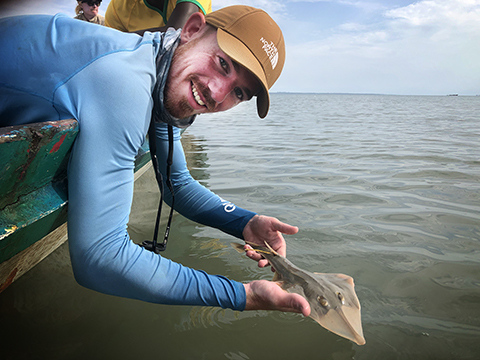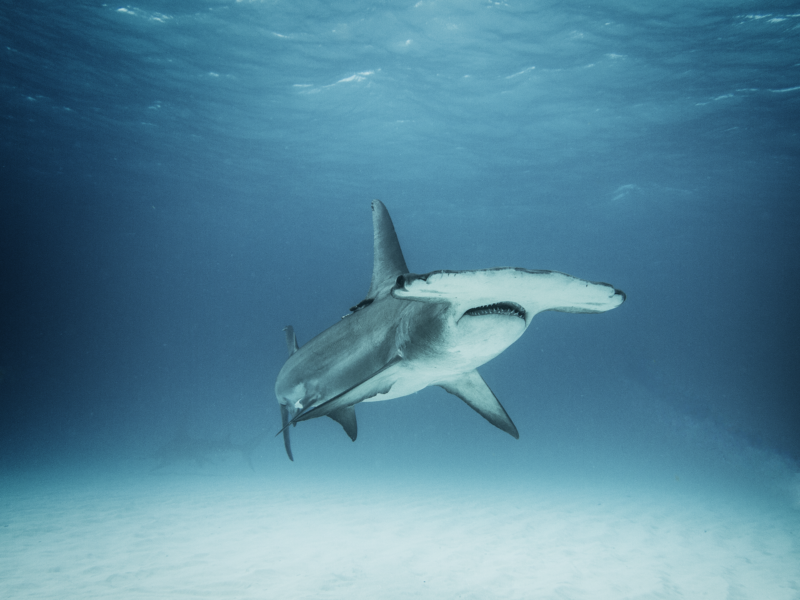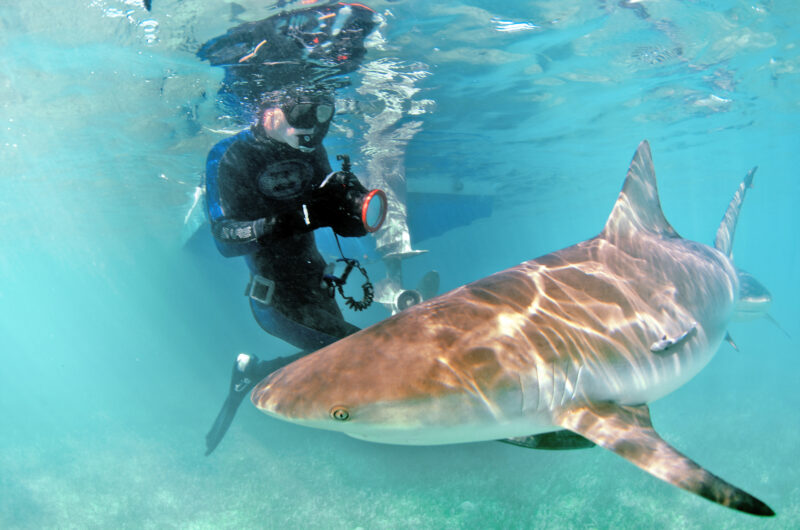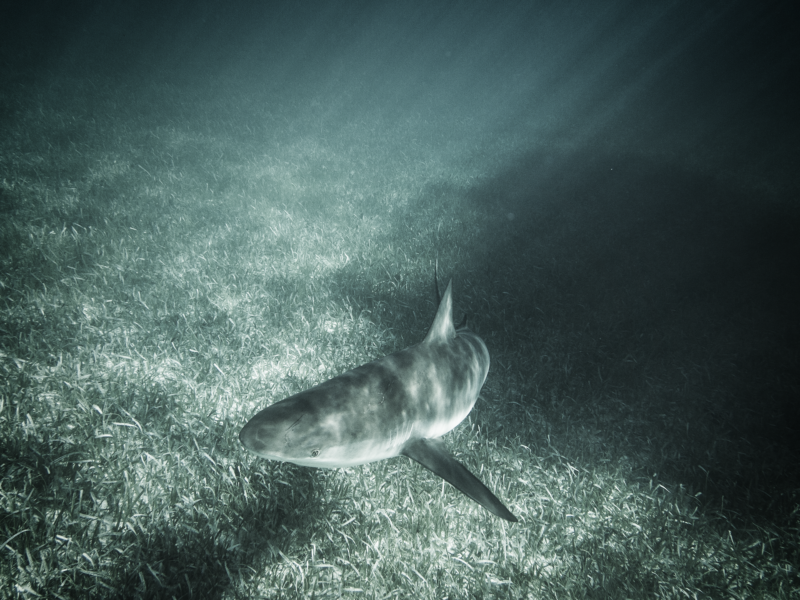
Guido Leurs and the food web in Africa
How sharks can protect wading birds
A young, seriously endangered blackchin guitar fish (Glaugostegus cemiculus) is released after having been studied (Bijagos archipelago, Guinea-Bissau). Photo by Nadia Hijner
The air is heavy with the scent of mud and salt. His feet are being sucked down by the sludge. A little ways away, the grey sand lies exposed from the retreating sea. But unlike at the Dutch mud flats, the wind isn’t harsh and cold; shark researcher Guido Leurs works in West Africa.
In South Africa, he went into the see to look at great white sharks up close. He swam with Caribbean grey reef sharks and studied hammerhead sharks in the Bahamas. But West Africa is different: the drifting mud means there is zero visibility under water, making diving impossible. Instead, he visits the fish markets and joins the local fishermen on their hunts to figure out what animals live just offshore of Guinea-Bissau.
His research is necessary, since it looks like the Asian love of shark fin soup threatens the lives of Dutch wader birds. Sharks that are caught off the West-African coast are sold on the international market.

Photo by Guido Leurs
Large hammerhead shark (Bimini, Bahamas). Photo by Guido Leurs
Fascination
Does he consider himself to be a thrill seeker? After all, sharks can do quite a bit of damage. ‘I’ve always enjoyed doing dangerous things. I think it’s fascinating’, says Leurs. As a kid, he always wanted to have a snake for a pet.
‘But I got really into animals when my father showed me horror classics like Deep Blue Sea and Jaws’, he says. In the library, he read every single book about sharks – and stingrays, because he loves those, too. ‘I quickly learned that the image of sharks as dangerous was incorrect. Although I have to admit that Sharknado remains a guilty pleasure of mine.’
It’s weird that I’m being paid to do this
‘Sharks are the top predators in the ocean’, says Leurs. ‘They’re perfectly adapted to their habitat, through hundreds of millions of years of evolution.’ Every shark and every stingray is different. Hammerhead sharks and guitar fish use their heads as metal detectors, while cownose rays have large, muscular jaws that are perfect for breaking open shellfish. While these animals have been studied a lot, there is still much that we don’t know about them.
Leurs decided to study biology in order to become a shark researcher. His lecturer tried to give him a reality check by saying the chances of him actually being able to work with sharks were slim to none, but he persevered. He still can’t really believe it all worked out. ‘I think it’s weird that I’m being paid to do this.’
Fishing trips
He may not be able to go diving in West Africa, but that makes the research all the more interesting. ‘We know next to nothing about the shark and ray species in this area. It’s a blind spot.’
Researchers don’t even know what kind of species live in the tidal zones, which means it’s difficult to determine how they are doing. That means that much of Leurs’ work, like joining the local fishermen on their hunt, is foundational. ‘They know the area like no other’, he says. ‘They know exactly where to look for what they want.’ Leurs himself goes fishing, too: he studies his catch and then returns it to the ocean, alive.
The fishermen are happy to share the information with Leurs; after all, he’s not your average tourist. As long as no one interferes with their work, it’s all good. The researcher understands their stance, since the work is their source of income.
At the markets, dozens of stalls of dried and fresh fish stationed along the beach, he looks for stingrays. Not only does this help him inventory the types and numbers of rays along the coast, but he also takes samples to analyse in the lab.

Snorkelling at the Bahamas as part of a research project into the behaviour of sharks around divers and swimmers. Photo by Amanda Nicholls
Shorebirds
Leurs works with researchers from the university of Aveiro in Portugal, who collect down feathers from wading birds in the area for their own research into the birds’ migratory behaviour and diet. Because Leurs’ research is not just aimed at finding out more about West African sharks and stingrays. He really wants to know more about the role of those animals in an intricate food web that also involves wading birds and crustaceans.
In fact, his research is funded not only by the marine research institute NIOZ, but also by a Dutch wading bird fund. But what do West African sharks have to with Dutch sanderlings?
The shark and stingray species are a blind spot in this area
‘Dutch wading birds winter in the tidal zones on the West African shore’, Leurs explains. ‘At low tide, they peck at the crustaceans in the sand. However, we think the rays eat those same crustaceans during high tide.’
Sharks end up eating the rays. As long as there isn’t a surplus of rays around, there are plenty of crustaceans for everyone.
But that’s exactly where things are going wrong, Leurs thinks. Because it looks like there are, in fact, too many rays around. And that may be because people love sharks too much. Specifically, the sharks’ flesh.
‘That means an excess of rays to eat the crustaceans from the bottom’, says Leurs. The wading birds are threatened with starvation, which means they’d lack the energy to fly back to the Netherlands in the summer. ‘That may partially explain why the number of wading birds has declined so much in the past few decennia’, he says.
Isotopes
Leurs isn’t a hundred percent convinced of his theory yet, though, which is why he’s taking samples of fish muscle back to the lab, where he’ll look for atoms with an unusual weight, called isotopes. The Portugese researchers are doing the same thing with the down feathers they’ve collected.
They’re looking for nitrogen and carbon isotopes in particular. There are a few different varieties of these kinds of isotopes; there is carbon-12 and nitrogen-14, the ‘standard atoms’ with twelve and fourteen core particles, respectively. But each atom has a heavier counterpart: carbon-13 and nitrogen-15.
Nitrogen and carbon accumulate in tissue. How much of each isotope is contained in a body depends on the food that body eats. When one animal eats another, the same ratio of isotopes is found in the predator. In short, if birds and fish have about the same isotope ratio, that means they’re eating the same kind of crustaceans.

Caribbean reef shark on a field of seagrass in the Abaco islands, Bahamas. Photo by Guido Leurs
In between expeditions, Leurs is trying to talk to the people of Guinea-Bissau about the dangers of overfishing. The sharks and rays are probably the top predators in the West African tidal flat area, which means they keep the entire food web in check, says Leurs. They eliminate sick and weak animals so they can’t propagate. If you remove the sharks and rays from the ecosystem, too many sick animals will survive, which means people will no longer be able to eat fish.
‘We can come up with all kinds of solutions’, says Leurs, ‘but if the overfishing and habitat destruction doesn’t stop, those solutions won’t help a bit.’
Sharks that bare their teeth have always been provoked
He wants to share his love for sharks with the rest of the world and make others fall in love with them too. He organises shark and stingray safaris off the Azores and posts fantastic photos of the fearsome fish on his Instagram account.
All underwater creatures are beautiful, but Leurs thinks sharks and rays are the coolest. He’s happiest swimming underwater and coming back up with a beautiful photo. Every picture tells a story, and he’s all too eager to tell it. He wants to dispel the stereotype that Jaws propagates. ‘I deliberately never post photos of sharks baring their teeth’, says Leurs. ‘Those animals are always provoked in an effort to make them look shark-ier. It sends the wrong message. I want to show the world that sharks are misunderstood. They are beautiful, sensitive animals.’

